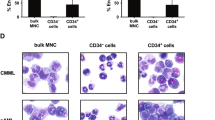Abstract
Although the mobilization and harvesting of Philadelphia chromosome-negative progenitors has been proven feasible by a number of groups, it is not clear which techniques should be used with regard to the monitoring of purging and evaluation of stem cell yield. Therefore, we isolated CD34-positive cells from leukapheresis samples of seven CML patients after induction therapy. These cells were analyzed using the colony-forming unit granulocyte–macrophage (CFU-GM) and long-term culture-initiating cell (LTCIC) assays. In addition, we analyzed frequency and clonogenicity of single stem cells using the LTCIC assay at limiting dilution. Individual colonies derived from these assays were subsequently analyzed for the presence of the bcr-abl gene with interphase fluorescence in situ hybridization (FISH) and for the presence of bcr-abl mRNA with RT-PCR. We compared these results with the cytogenetic analysis of the leukapheresis material. Molecular analysis of individual colonies correlated well with the results of cytogenetic analysis. However, in nine out of 18 samples, cytogenetic analysis exclusively demonstrated the presence of either Philadelphia chromosome-positive or -negative cells whereas with the molecular analysis of individual colonies tumor contamination or the presence of residual normal cells could be substantiated. We concluded that molecular analysis of individual colonies should be employed to further optimize induction protocols. With regard to stem cell mobilization we demonstrated that about 67 CFU-GM colonies and clusters were generated by one single LTCIC both for the CML samples and the samples obtained from patients with non-hematologic malignancy. This number is important since until now most centres use a number of four colonies and clusters generated by one LTCIC. Dividing the CFU-GM output in the LTCIC assay by four to determine LTCIC frequency could thus lead to an almost 20-fold overestimation of the LTCIC frequency. It is concluded that stem cell frequency analysis is an important tool with regard to the interpretation of mobilization protocols.
This is a preview of subscription content, access via your institution
Access options
Subscribe to this journal
Receive 12 print issues and online access
$259.00 per year
only $21.58 per issue
Buy this article
- Purchase on Springer Link
- Instant access to full article PDF
Prices may be subject to local taxes which are calculated during checkout
Similar content being viewed by others
Author information
Authors and Affiliations
Rights and permissions
About this article
Cite this article
Thijsen, S., Schuurhuis, G., van Oostveen, J. et al. Mobilization of hematopoietic progenitors in patients with chronic myeloid leukemia. Bone Marrow Transplant 20, 835–842 (1997). https://doi.org/10.1038/sj.bmt.1700991
Received:
Accepted:
Issue Date:
DOI: https://doi.org/10.1038/sj.bmt.1700991
Keywords
This article is cited by
-
Storage of unprocessed G-CSF-mobilized whole blood in a modified Leibovitz's L15 medium preserves clonogenic capacity for at least 7 days
Bone Marrow Transplantation (2001)



